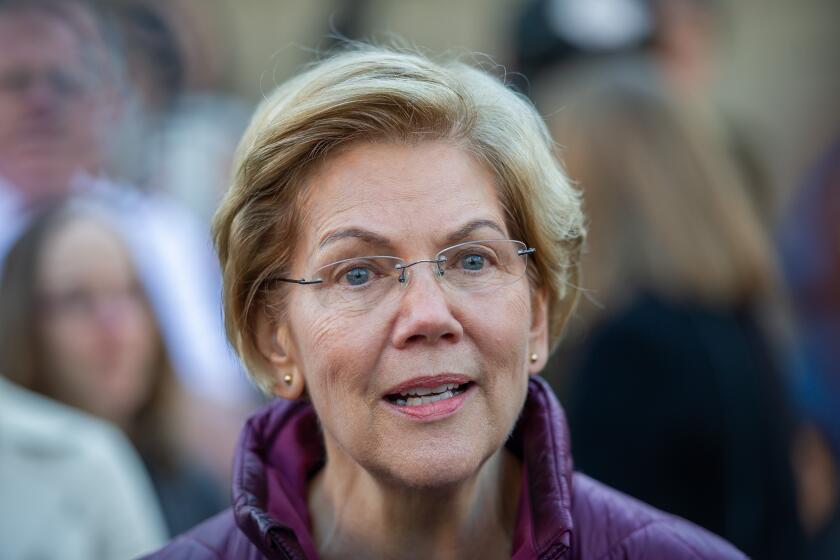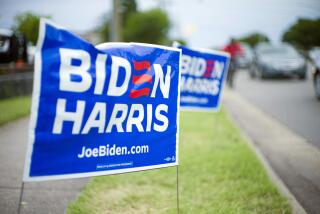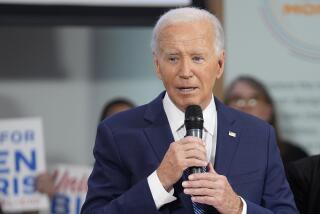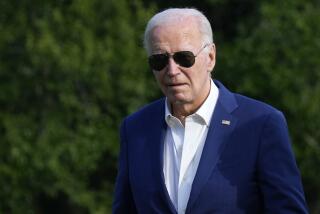Biden and Sanders both would face stark challenges running against Trump
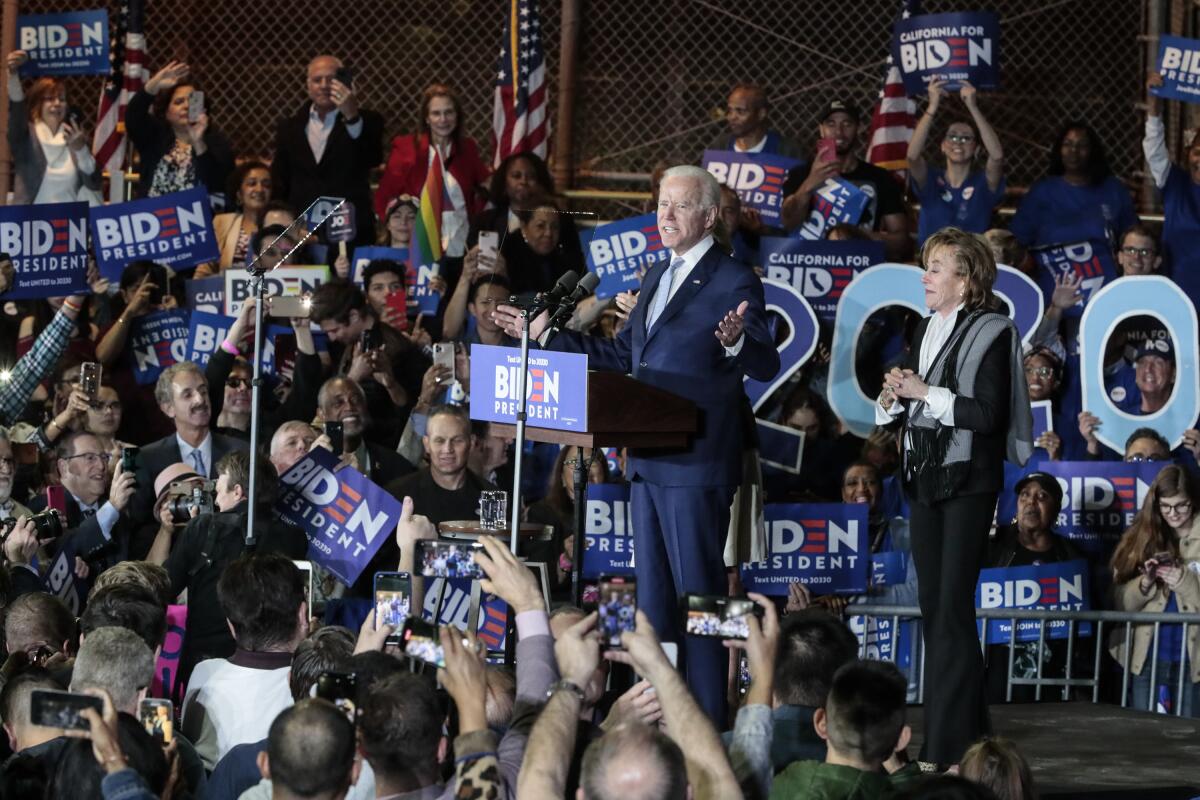
WASHINGTON — If there is one thing essential for Democrats as they look toward taking on President Trump in November, it is a nominee who can drive strong, perhaps historic, turnout, either by reassembling the coalition that twice elected Barack Obama or by mobilizing masses of new voters.
Yet the party is now barreling toward its nominating convention with the race mostly whittled down to two candidates in their late 70s who both have big weaknesses in reaching beyond their respective bases.
Bernie Sanders and Joe Biden will face a crucial test in the remaining states in the Democratic primary, where both will have to recalibrate and — to some extent rebrand — to broaden their appeal and unify a fractured party. It is a tall order for two men who are products of an earlier generation of politics.
“To beat Trump is going to take an all-of-the-above approach, what we saw in the midterm elections: expanded youth turnout, expanded turnout among people of color and continuing to win crossover votes among better-educated independents and Republicans,” said Tom Bonier, chief executive of TargetSmart, a Democratic data analytics firm.
“Whoever the Democratic nominee is, they are going to have to check all those boxes,” he said.
Bonier and other party strategists are confident that challenge will prove easier to overcome than the challenges Trump faces in rebuilding his own winning coalition. But the risks are large for both Democratic candidates, and for the party.
For many women, Elizabeth Warren dropping out of the presidential race was a familiar punch to the gut. The highest glass ceiling in the land remains intact.
Each of their campaigns insists it is poised to draw groups of voters who have not been enthusiastic about their politics and to craft a pitch that crosses ideological and demographic boundaries, as Obama succeeded in doing in 2008.
But Obama, a relative newcomer to the national political stage then, charged into his race free of the burdens that Sanders and Biden carry. Decades of experience helped propel the two septuagenarian politicians to the front of a huge field of candidates this cycle, but that also weighs them down as they struggle to reach new audiences.
“He’s going to talk about building a big coalition,” Sanders campaign co-chair Ro Khanna, a Silicon Valley congressman, vowed in a video interview he posted Wednesday on Twitter. “He is committed to being a unifier.”
That message reflected an insurgent campaign chastened by Super Tuesday election returns that indicated Sanders needs to adjust his approach.
But even as the Biden campaign reveled in its success Tuesday, advisors acknowledged that the former vice president, too, must expand his reach.
“This is somebody whose campaign is fundamentally about hope and optimism, but I think you’re going to hear a lot that’s from the vice president continuing about not just the experience of the past, but the vision for the future,” Los Angeles Mayor Eric Garcetti, a co-chair of the Biden campaign, told reporters Wednesday.
Biden came out of Super Tuesday with several accomplishments to boast of. Turnout hit record levels in some states he carried, notably Virginia. Biden did extremely well in suburban areas among the sorts of moderate voters — many of them former Republicans — who helped carry the Democrats to victory in the 2018 midterm election.
But his limited reach with voters younger than 45, whom Obama was so successful at energizing, is not encouraging for a Democratic Party eager to attract new blood.
All of the memes of Biden in his aviator glasses and his campaign trail talk about student debt and sexual violence can’t mask some tough numbers. He drew just 17% of voters under 45 on Super Tuesday, according to exit polls.
Biden events routinely feature far more gray heads than nose rings. His old-school political style, his dated references to dead politicians like South Carolina Sen. Fritz Hollings and use of archaic words like “malarkey” all send a generational message that leaves many young voters scratching their heads. Many young Democrats believe the political and economic system isn’t working for them and want candidates who will shake things up, as many polls have shown.
“There is a pretty steep burden of proof for Joe Biden, first, to show young voters that he gets all of that and, second, that he can and will make the kind of changes that young voters are seeking,” said Geoff Garin, a Democratic pollster unaffiliated with any presidential candidate. “Some of this is about policy and some is just about tone and mindset and body language.”
The former vice president’s lackluster results with Latinos compound questions about whether he can make the inroads Democrats have long sought in Sunbelt states, notably Arizona and Texas. Some see worrisome echoes of Hillary Clinton’s failed presidential run in 2016, when the candidate’s dated messaging, establishment pedigree and lack of energy on the campaign trail left too many voters uninspired.
Yet it was Sanders who had by far the tougher night on Super Tuesday.
The Vermont senator has built his campaign around promises that he would mobilize masses of voters who had not participated in the process before. He hasn’t.
Sanders did well with those young people who did show up, but he did not significantly expand their turnout — as the candidate acknowledged Wednesday.
“This is a campaign which is trying to bring — and it is not easy — people who have not been involved in the political process,” Sanders said at a news conference in Burlington, Vt.
“Have we been as successful as I would hope in bringing young people in? The answer is no. ... Everybody knows that young people do not vote in the kind of numbers that older people voted. I think that will change in the general election.”
That is a big leap of faith Sanders is asking of voters looking for the candidate who can drive turnout against Trump. During his remarks, Sanders spent a lot of time arguing that building his movement is hard, time-consuming work. He spent no time broadening his pitch to voters.
The other major problem the Vermont senator has worked feverishly to fix — without much success — is lack of support among African Americans.
Their chilly reaction to him, especially in the South, derailed his campaign in 2016. This week, those voters once again showed little enthusiasm for him. They rejected his candidacy in numbers so great that Sanders, who went into Super Tuesday widely projected to gather most of the delegates at stake, could not keep pace with Biden.
Failure to generate a big turnout among African American voters contributed to Clinton’s loss of key states to Trump in 2016, notably Pennsylvania and Michigan. Sanders’ weakness with that key Democratic constituency could once again cost him the nomination, but also might create a serious problem if he were the nominee.
One bright spot for Sanders was his win in California, which he said shows he can build a large multiracial coalition.
“If you look at people of color in general — African Americans and Latinos, Asian Americans — we won that big time” in California, Sanders said. “Not even close. So we are doing very well with people of color; we’re going to do better, I think, with the African American community.”
The Biden campaign made similarly optimistic comments about its appeal to Latinos. Both campaigns, though, struggled to articulate a coherent plan.
Asked how Biden would increase his standing in the Latino community, Garcetti offered an anecdote involving a personal encounter between Biden and a young immigrant “Dreamer” in a Los Angeles parking lot.
“I know that connection voters feel with him,” the mayor said. “And the more they learn about him, the more they love them.”
It was a moving anecdote. The next several weeks will show whether either campaign can turn such gauzy hopes into reality.
More to Read
Get the L.A. Times Politics newsletter
Deeply reported insights into legislation, politics and policy from Sacramento, Washington and beyond. In your inbox three times per week.
You may occasionally receive promotional content from the Los Angeles Times.
